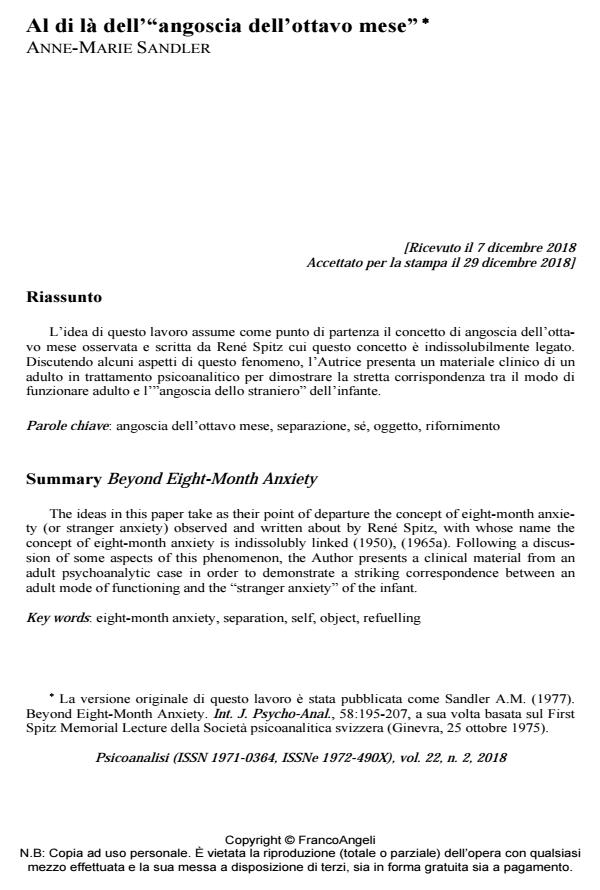Al di là dell’"angoscia dell’ottavo mese"
Titolo Rivista PSICOANALISI
Autori/Curatori Anne-Marie Sandler
Anno di pubblicazione 2019 Fascicolo 2018/2 Lingua Italiano
Numero pagine 21 P. 43-63 Dimensione file 209 KB
DOI 10.3280/PSI2018-002004
Il DOI è il codice a barre della proprietà intellettuale: per saperne di più
clicca qui
Qui sotto puoi vedere in anteprima la prima pagina di questo articolo.
Se questo articolo ti interessa, lo puoi acquistare (e scaricare in formato pdf) seguendo le facili indicazioni per acquistare il download credit. Acquista Download Credits per scaricare questo Articolo in formato PDF

FrancoAngeli è membro della Publishers International Linking Association, Inc (PILA)associazione indipendente e non profit per facilitare (attraverso i servizi tecnologici implementati da CrossRef.org) l’accesso degli studiosi ai contenuti digitali nelle pubblicazioni professionali e scientifiche
L’idea di questo lavoro assume come punto di partenza il concetto di angoscia dell’otta¬vo mese osservata e scritta da René Spitz cui questo concetto è indissolubilmente legato. Discu-tendo alcuni aspetti di questo fenomeno, l’Autrice presenta un materiale clinico di un adulto in trattamento psicoanalitico per dimostrare la stretta corrispondenza tra il modo di funzionare adulto e l’"angoscia dello straniero" dell’infante.;
Keywords:Angoscia dell’ottavo mese, separazione, sé, oggetto, rifornimento
- Ambrose J.A. (1961). The development of the smiling response in early infancy. In: Foss B.M. (ed.), Determinants of Infant Behaviour, vol. 1. New York: Wiley.
- Benjamin J.D. (1963). Further comments on some developmental aspects of anxiety. In: Gaskill H.S. (ed.), Counterpoint. New York: Int. Univ. Press.
- Brazelton T.B., Tronick E., Adamson L. (1975). Early mother-child reciprocy. In: Parent-Infant Interaction (Ciba Foundation Symposium 33, New Series). Amsterdam: Elsevier, Exc. Med.
- Decarie T.G. (1974). The Infant’s Reaction to Strangers. New York: Int. Univ. Press.
- Deutsch H. (1942). Some forms of emotional disturbance and their relationship to schizophrenia. Psychoanal. Q., 11: 301-321.
- Festinger L. (1957). A Theory of Cognitive Dissonance. Evanston, Ill.: Row, Peterson.
- Goldstein K. (1942). Brain Injuries in War. London: Heinemann.
- Mahler M., Pine F., Bergman A. (1975). The Psychological Birth of the Human Infant. New York: Basic Books.
- Sandler J. (1960). The background of safety. Int. J. Psycho-Anal., 41: 352-356.
- Spitz R.A. (1950). Anxiety in infancy: a study of its manifestation in the first year of life. Int. J. Psycho-Anal., 31: 138-143.
- Spitz R.A. (1959). A Genetic Field Theory of Ego. New York: Int. Univ. Press.
- Spitz R.A. (1963). Life and the dialogue. In: Gaskill H.S. (ed.), Counterpoint. New York: Int. Univ. Press.
- Spitz R.A. (1964). The derailment of dialogue: stimulus overload, action cycles and the completion gradient. J. Am. Psychoanal. Ass., 12: 752-775.
- Spitz R.A. (1965a). The First Year of Life. New York: Int. Univ. Press.
- Spitz R.A. (1965b). The evolution of the dialogue. In: Schur M. (ed.), Drives, Affects, Behavior, vol. 2. New York: Int. Univ. Press.
- Spitz R.A., Wolf K.M. (1946). The smiling response. Genet. Psychol. Monogr., 34: 57-125.
- Winnicott D.W. (1956). On transference. Int. J. Psycho-Anal., 37: 386-388.
- Wolff P.H. (1963). Observations on the early development of smiling. In: Foss B.M. (ed.), Determinants of Infant Behaviour, vol. 2. New York: Wiley.
Anne-Marie Sandler, Al di là dell’"angoscia dell’ottavo mese" in "PSICOANALISI" 2/2018, pp 43-63, DOI: 10.3280/PSI2018-002004